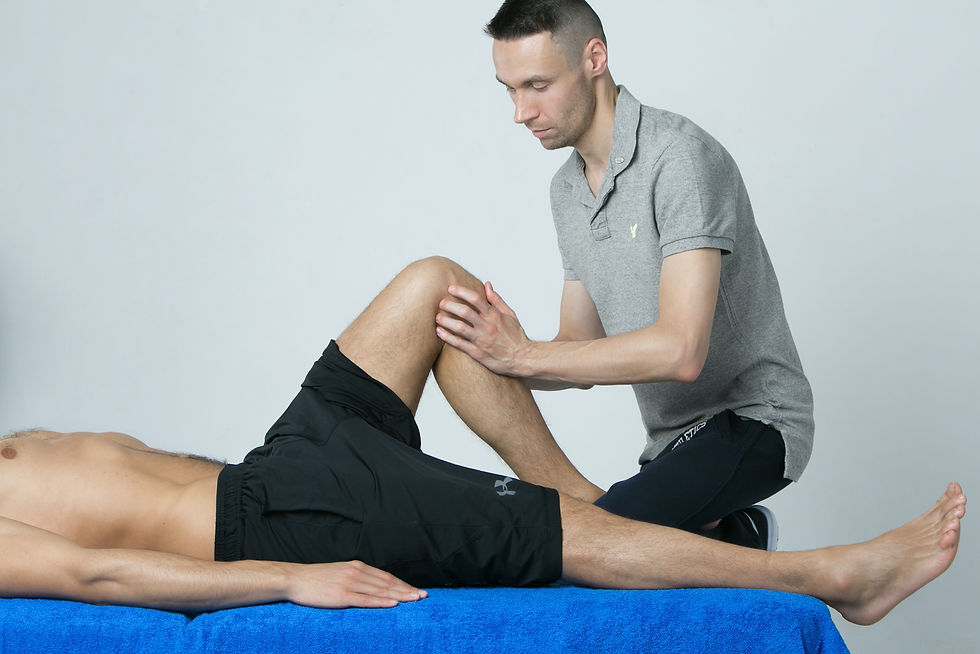Why Your Old Injury Keeps Coming Back (and What to Actually Do About It)
- Stephen Lunt

- Apr 28
- 4 min read
You know the one...
That calf niggle that rears its head every time you decide it’s a good day for a 5K.
That dodgy shoulder that waits until you're halfway through a gym session to remind you it exists. Or that knee that behaves itself... until you even think about playing five-a-side.
Old injuries have a nasty habit of sticking around longer than a bad smell. And here's the thing — it’s not just bad luck or “getting older”.
There's always a reason behind it — and (good news) there's usually a fix too.

So, why exactly do old injuries keep coming back? And more importantly, what can you actually do about it?
Let’s break it down.
Why Do Old Injuries Keep Coming Back?
1. Poor Rehab the First Time Around
Let’s be honest — most people stop their rehab way too early. As soon as the pain fades and things feel “OK”, it’s back to normal life: running, cycling, gym sessions, Sunday league — no questions asked.
The problem? Pain is just one part of recovery. The muscle strength, balance, joint control and movement patterns often haven’t fully come back yet.
So while you might feel fine at rest, when you put your body under load — bang, there’s the old injury back to ruin your plans.
2. Returning to Sport Too Quickly
There’s a big difference between being pain-free and being sport or pre-injury activity-ready. Getting back on the bike, into the gym or onto the pitch too soon is a recipe for disaster.
Think of it like fixing a cracked wall with sticky tape — it might look OK for a bit, but the minute you lean on it, it gives way.
Good rehab builds you back up not just for everyday life, but for the demands of your sport — sprinting, jumping, lifting, sudden changes of direction, you name it.
3. Ignoring Underlying Issues
Most injuries aren’t just random bad luck — they happen because something was a bit “off” to begin with.
Weak glutes, tight hips, poor ankle stability, rotator cuff weakness, lack of thoracic extension etc etc etc.
If these things contributed to the injury the first time and they haven’t been sorted, guess what?
They’re still lurking, ready to cause more grief.
4. Compensation and Bad Habits
Your body’s clever — it finds ways to get the job done, even when something isn’t quite right.
If your left ankle is stiff, your right hip will work overtime. If your hamstring’s a bit dodgy, your back muscles might chip in more than they should.
It keeps you moving — but over time, these compensations create new problems... or wake up the old ones.
What You Should Actually Do About It
OK, enough doom and gloom.The good news is, old injuries can be sorted — properly — so you can get back to doing what you love without worrying about the wheels falling off.
Here’s how:
1. Get a Proper Assessment
First things first — you need to know what’s really going on.

Not just “my knee hurts”, but why it’s hurting. Which muscles are weak? Which joints are stiff?What movement patterns are dodgy? Where are your compensations coming from?
A thorough assessment (like the ones I offer here at Restore) looks at your whole kinetic chain — not just the sore bit — to uncover the hidden culprits.
2. Rehab Properly — Not Just Until It Feels OK
This is where most people fall short.
Proper rehab is progressive. It starts by settling symptoms, then builds strength, control, and movement quality back up step by step — until you’re not just pain-free, but resilient.
It’s a bit like re-building a house after a flood: you don’t just mop up the water and move back in. You fix the foundations first and build up your defences or you’ll be back where you started before long.
3. Strengthen Your Weaknesses
Old injuries can often highlight where you’re vulnerable. That’s not a reason to panic — it’s valuable information.
Rehab gives you a golden opportunity to build yourself stronger than before. Whether it’s glutes, ankles, shoulders or core strength — shoring up the gaps can make a huge difference not just to injury risk, but to performance too.
No more feeling like you’re held together with duct tape.
4. Don’t Rush the Comeback
I get it. You’ve been sidelined. You’re itching to get back to your runs, your rides, your matches.
But if you rush it, you’re just setting yourself up for another setback. A few extra weeks of smart, structured rehab can save you months — or even years — of yo-yoing between hope and frustration.
Patience pays off.

Final Thoughts
You don’t have to accept “my dodgy knee” or “my bad back” as part of getting older. That’s not ageing — that’s unfinished business.
The truth is, your body is brilliant at healing — if you give it the right help.Get a proper assessment, stick to a solid rehab plan, address the real issues and you’ll be amazed at how much better (and stronger) you can feel.
Ready to finally put that old injury behind you? At Restore Sports Injury and Performance, I help weekend warriors, casual athletes and regular gym-goers just like you get back to what they love — stronger, fitter and without that constant fear of breaking down again.
Drop me a message or book a free discovery call — and let’s sort it properly this time.



Comments